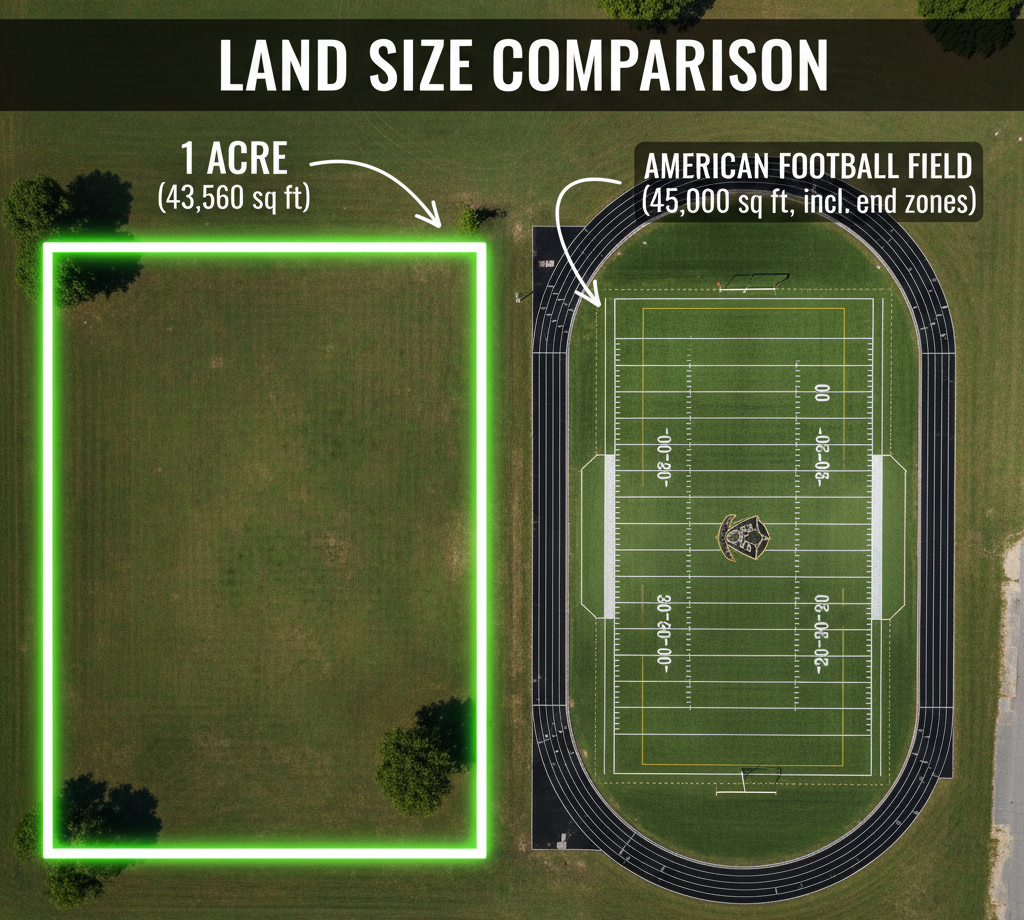When it comes to measuring large areas of land, the acre is one of the most commonly used units. However, for many people, imagining the size of an acre can be difficult. That’s why a popular comparison is made between 1 acre and a football field. Since football fields are familiar landmarks, they provide an easy way to visualize land measurements.
In this detailed guide, we’ll break down how 1 acre compares to a football field, the exact dimensions involved, and why this comparison is useful for real estate, farming, sports discussions, and education.
What Is an Acre?
An acre is a unit of land measurement used in the United States and several other countries. One acre equals:
43,560 square feet
4,840 square yards
0.4047 hectares
The acre does not have fixed dimensions (length × width). Instead, any rectangular or square area that equals 43,560 square feet is considered one acre. For example:
66 feet × 660 feet = 1 acre
100 feet × 435.6 feet = 1 acre
This flexibility makes the acre a useful unit for land of different shapes and purposes.
Dimensions of a Football Field
To compare an acre to a football field, we first need to know the size of a standard football field. In the United States, an American football field is:
360 feet long (including both end zones)
160 feet wide
This equals 57,600 square feet.
However, if you only measure the playing field without end zones, the field is 300 feet long × 160 feet wide, which equals 48,000 square feet.
1 Acre to Football Field: The Comparison
Now let’s compare:
1 acre = 43,560 sq. ft.
Football field (with end zones) = 57,600 sq. ft.
Football field (without end zones) = 48,000 sq. ft.
So, one acre is:
About 76% of a full football field with end zones
About 90% of a football field without end zones
In simpler terms, if you took an acre of land and placed it on a football field, it would cover most of the playing surface but not quite the entire field.
Visualizing 1 Acre in Everyday Life
Comparisons make measurements easier to understand. Beyond the football field, here are some other ways to visualize one acre:
About 16 tennis courts
Around 70 average-sized parking spaces
Roughly the size of 1½ basketball courts side by side
A square plot measuring 208.7 feet on each side
Still, the football field comparison remains the most popular because of how familiar people are with its dimensions.
Why the Acre-to-Football-Field Comparison Matters
The acre-to-football-field analogy is useful for several reasons:
Real Estate: Buyers often find it easier to picture property size when compared to a football field rather than a raw number of square feet.
Farming and Agriculture: Farmers frequently calculate crop yields and land divisions in acres, so visual comparisons help in planning.
Sports and Education: Teachers and coaches use football fields to explain land area to students in a relatable way.
Urban Planning: Comparing acres to football fields helps planners explain land use to the public in simple terms.
Historical Context of the Acre
The acre has historical roots going back to medieval England. Originally, it represented the amount of land one ox team could plow in a day. Over time, the acre was standardized into the 43,560 square feet we use today.
By contrast, football fields were standardized much later, with the first official rules in the late 19th century. The connection between acres and football fields likely began as a way for educators and surveyors to simplify measurements for the public.
Football Field Variations
While most comparisons use American football fields, it’s important to note that not all football fields are the same size.
Canadian Football Field: Larger at 450 feet long × 195 feet wide = 87,750 sq. ft. (nearly twice an acre).
Soccer Field (FIFA Standard): Ranges from 300–390 feet long × 150–300 feet wide. On average, a soccer field is 1.7–2 acres.
This means the acre-to-football-field analogy only works consistently with American football fields.
Practical Examples of Acre vs. Football Field
Buying Land for a Home: If a property is listed as 1 acre, you can think of it as almost a full football field without the end zones.
School Projects: Teachers can take students to a football field and show them how much of the field equals 1 acre (about 90%).
Community Planning: When cities build parks, the size is often described in acres, making football fields a useful comparison for public understanding.
Converting Acres to Football Fields
Since 1 acre is 43,560 sq. ft. and a football field (with end zones) is 57,600 sq. ft., we can do quick conversions:
1 football field ≈ 1.32 acres
1 acre ≈ 0.76 football fields (with end zones)
1 acre ≈ 0.91 football fields (without end zones)
This makes it easy to scale up:
5 acres = About 4 football fields
10 acres = About 7.6 football fields
20 acres = About 15 football fields
Common Misconceptions
Many people assume that one acre equals one football field, but as we’ve seen, that’s not exactly true. While they are similar in size, an acre is slightly smaller. This is why it’s more accurate to say that an acre is almost the size of a football field rather than exactly equal to one.
Looking Beyond: Acres in Larger Contexts
Understanding how 1 acre compares to a football field also helps when thinking about larger properties:
100 acres = About 76 football fields
640 acres = 1 square mile = About 484 football fields
These larger comparisons are especially useful in agriculture, real estate development, and forestry.
Conclusion
When people ask, “How big is an acre?” one of the simplest ways to explain it is by comparing it to a football field. One acre equals 43,560 square feet, which is roughly 90% of a standard football field without end zones or 76% of a full field including them.
This comparison not only makes land size easier to visualize but also connects measurements to something most people already understand. Whether you’re buying property, studying land management, or just curious about measurements, the acre-to-football-field analogy provides a clear and practical way to grasp scale.
So next time you hear someone talking about an acre of land, picture a football field—it’s not an exact match, but it’s close enough to give you a meaningful perspective.

